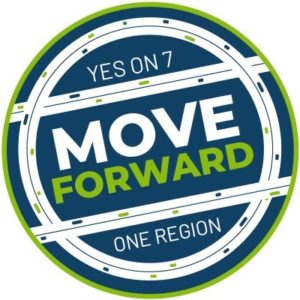Seven Reasons to Vote for Issue 7
Hamilton County ballot issue will fund new bus routes, road repairs
When you go to the polls in Hamilton County on Tuesday, March 17, we encourage you to support Issue 7 with a “Yes” vote. Issue 7 would replace Cincinnati’s 0.3 percent earnings tax with a 0.8 percent Hamilton County sales tax to reinvest in our transportation system, which is vital to promoting economic growth. The initiative will reinvest $130 million annually into improving our transportation system.
Issue 7 is supported by a diverse coalition of organizations and community leaders, including the Cincinnati USA Regional Chamber, Cincinnati Area Board of Realtors, Urban League of Greater Southwestern Ohio, the All-In Cincinnati Coalition, United Way of Greater Cincinnati and our own Women’s Fund of the Greater Cincinnati Foundation. It also has bipartisan support from such politicians as Hamilton County Auditor Dusty Rhodes (D) and State Rep. Bill Seitz (R-Green Township).
The transit model in Hamilton County, created nearly 50 years ago, needs to change to address the growth in our population, much of it outside of the city of Cincinnati. Because Metro’s “hub-and-spoke” system revolves around downtown, major employers and employment centers outside the city center are underserved.
“This is about getting more buses on the road to connect people to jobs,” Seitz told the Cincinnati Enquirer.
Along with The Women’s Fund, GCF recognizes that Issue 7 will help to advance racial equity and women’s economic self-sufficiency in our region, by making jobs more accessible to women of color.
Here are seven reasons for your “Yes” vote:
- Better connections to jobs. Lack of transportation is a key factor in employers’ challenges to filling jobs: more than half of all Metro rides are to and from work.
- Major infrastructure improvements. Much-needed repairs to the Western Hills Viaduct and outdated bridges throughout Hamilton County, among other projects, will receive 25 percent of the budget, or about $30 million annually.
- Less waiting. The plan includes additional bus routes and more frequent buses.
- Extended hours. Jobs, particularly in the service industry, are not 9:00 to 5:00, and that is where many low-wage workers are employed. The plan includes more weekend hours and several 24-hour routes.
- Shorter trip time. The addition of eight cross-town routes will require far fewer transfers and multiple-route trips.
- Ridership cost savings. Zoned fares and transfer costs would be eliminated, and a fund would be created to provide free or discounted bus passes to eligible low-income citizens.
- The new funding model is broader-based, with county-wide revenue support reflecting the Metro service area and ridership base.
For further information, visit www.moveforwardcincy.com and www.reinventingmetro.com.

